William Weston
Investigative journalist Elzie Glaze said regarding the Kennedy assassination, “There is a very large spider guarding this web of secrecy. I have entered other webs, but this one is different because the spider leaves the web and stalks its prey – sometimes for many years.” [1] The spider was the Texas School Book Depository, and its web was in Dealey Plaza. It was a front for gun running, narcotics smuggling, and gathering intelligence on leftist organizations. Glaze’s metaphor shows that it also harbored a death squad that could, when it chose, set out to eliminate troublesome individuals who knew too much.
Virtually unknown today was the existence of another deadly spider that built its web in the vicinity of the Trade Mart near the intersection of Industrial and Harry Hines.
Since the early 1950’s Harry Hines Boulevard was the scene of a major construction boom. The newly built St. Paul’s Hospital, only three blocks from Parkland Hospital, was scheduled to receive its first patients in December 1963. Nearby was the Market Center consisting of three buildings, the Homefurnishings Mart, the Trade Mart, and Market Hall. An expansion to Market Hall was completed in April 1963, making it the largest privately owned exhibition hall in the world. A fourth building, the Apparel Mart, with over one million square feet of air-conditioned space, was due for completion in 1964. The office complex of Stemmons Towers, four of them twelve stories high, had one tower up and open for business, and a second in the process of construction. The Stemmons Towers and Market Center were projects of Trammell Crow, a well-known real estate developer and confidant of conservative Republicans, such as Richard Nixon, Gerald Ford, and George H.W. Bush.
With so much building going on, the construction of a new schoolbook depository would have received little attention. It was only a short distance from the Trade Mart, just beyond the train track, on Harry Hines Boulevard. This same railroad crossing appears in Vincent Bugliosi’s book Reclaiming History, describing limousine driver Bill Greer’s frantic race to Parkland Hospital.
The motorcade exits the freeway onto the service road, barely slowing to make the right turn onto Industrial Boulevard, where the entrance to the Trade Mart was located. . . . The motorcade fast approaches Harry Hines Boulevard, where they’ll have to navigate a forty-five degree left turn toward Parkland Hospital. Just before Harry Hines, the road rises sharply to cross a railroad grade. The motorcycle escorts are familiar with the turn, but limousine driver Bill Greer is not, and he pushes the president’s car faster, moving dangerously close to the motor jockeys.
With the limousine’s front grill barking at their heels, the police escorts hit the rise wide open, go airborne, and nearly lose control as they slam to earth in the middle of the boulevard, thirty feet away. On contact, the Harley Davidson motorcycles bank hard into the left turn, sparks kicking up from their footstands dragging across the pavement.
The president’s car is right behind them, hitting the rise with a Whump! then into the turn on squealing tires. Greer is doing all he can to handle the careening limousine, which bumps J.W. Courson’s motorcycle briefly into the curb. The men frantically pull out of the turn and accelerate toward the emergency entrance of Parkland Hospital three-quarters of a mile up the road. It’s a wonder they haven’t been wrecked yet. [2]
The near wreck of Courson’s motorcycle occurred almost in front of the Lone Star School Book Depository, a two-story, masonry office building, with a flat roof. It had a warehouse in back, built with pre-cast, concrete tilt-walls and steel frame, twelve feet high, 160 by 240 feet, with a sloped roof. The LSBD recently moved here from its old location on Browder Street in downtown Dallas, where it had been since the mid-1920’s. The company was formed in 1923 when Forrest R. Carlton, William E. Zehner, and Henry J. Landrum bought the remaining assets of the defunct Southern School Book Depository, based in Atlanta, Georgia. The assets came from the Dallas office, which the Georgia firm opened in 1907, a year before the establishment of the Texas School Book Depository.
The new facility was built on a vacant area that originally belonged to the Texas Highway Commission. The land was triangular in shape, consisting of 7.68 acres, bounded by Harry Hines Boulevard, Kendall Lane, and the MKT railroad. In 1956 the commission removed a pair of galvanized metal storage sheds, divided the land into three lots, and put them up for bid (Dallas Morning News 11-16-56).Although it received a fair number of bids, the only one it accepted was for the lot adjacent to Kendall Lane, at 4646 Harry Hines, sold to Binswanger Glass for $125,000. The commission decided to defer selling the other two lots until a later time (DMN 11-23-56).
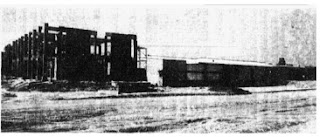 |
| Picture 1 |
Soon after the opening of the Binswanger facility, construction began at 4640 Harry Hines for the Lone Star School Book Depository (DMN 11-18-62). (See Picture 1 of building under construction and Picture 2 of modern view).
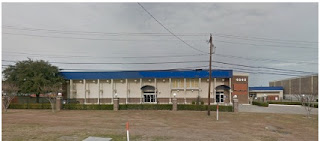 |
| Picture 2 |
Handling all phases of construction was Delta Steel, which specialized in the design, factory-fabrication, and erection of metal buildings. Conveniently, the construction firm was located across the street at 4501 Harry Hines. Shortly after finishing the LSBD, it moved to a new 8000-square-foot building on Luna Road (DMN 7-7-63). The timing of this move suggests that Delta Steel managers foresaw some notoriety coming upon their former client, and they wanted to disassociate themselves as much as possible.
Construction on the third lot began in April 1963 for General Automotive Parts. This company came into existence in late 1962 with the merger of four previously existing corporations. Its new headquarters was going to be a three-story building at 4600 Harry Hines with over 113,000 square feet of warehouse and office space. Since the firm was a member of National Automotive Parts Association, the NAPA name appeared on the side of the building in large, block letters. (See Picture 3)
 |
| Picture 3 |
Occupation of the building was scheduled for February of the following year (DMN 4-10-63). Six months later, an aerial photo of the area shows that the exterior had reached its final stage (DMN 10-6-63). Still to be done probably was interior work such as carpeting, tiling, and overhead lighting. Also a large number of auto parts had to be hauled in, organized, and put on shelves. The warehouse had about 65,000 separate items, making up fifty principle lines of automotive parts and supplies and 300 lesser lines. An article announcing that General Automotive Parts was open for business appeared several months later (DMN 3-1-64).
The consecutive construction of three buildings in a row made the emergence of the LSBD less noticeable to passing motorists. After completion, the two buildings on each side reduced the visibility of the LSBD – a desirable effect for those who planned to use the premises for a nefarious purpose.
When the president came to Dallas, people standing in front of, or near, the LSBD might have been astonished at the recklessness of the president’s limousine tearing down Industrial Boulevard and briefly going airborne over the railroad grade. As an experienced driver, Greer should have known that when crossing a train track, he must brake to a suitably slow speed to avoid losing control.
Now if Greer had to go slow in one direction, it is of course logical that he had to slow down coming from the opposite way. Let us assume that the motorcade had not gone the way it actually went historically, but instead departed from Love Field using an alternate route. As the procession went south on Harry Hines Boulevard, it had to cross the train track before it could get to the Trade Mart. Here the president’s driver had to slow down to a crawl, or stop completely, waiting for (1) the advance car, (2) the pilot car, (3) five lead motorcycles, and (4) the lead car to take their turns maneuvering over the track. Immediately to the left of this spot and not more than 200 feet away was the schoolbook depository, well within the range of a trained sniper. Just as the 120 degree turn from Houston onto Elm was a potential motorcade trap, so also was the railroad crossing.
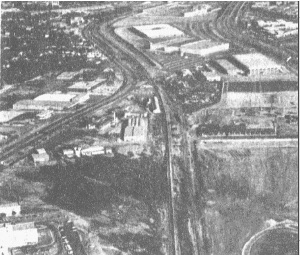 |
| Picture 5 |
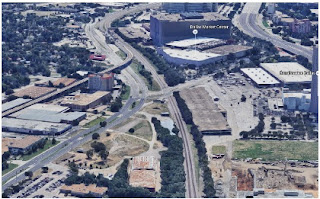 |
| Picture 6 |
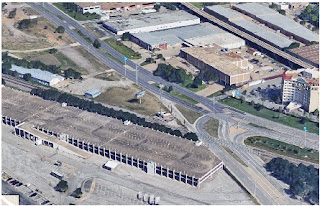 |
| Picture 7 |
Governor John Connally wanted the Trade Mart, because he believed that the people attending there would be politically useful in the upcoming 1964 campaign. Bruno wanted the Women’s Building because it was accessible to traditional supporters of the president, such as women, chicanos, blacks, and union workers. It was also preferable from a security standpoint. The Trade Mart required more vigilance and caution with its numerous entrances, tiers of balconies surrounding the central court, and catwalks at every level. In spite of these risks, the Trade Mart became the chosen site for the luncheon. Kenny O’Donnell told the disappointed Bruno, “We’re going to let Connally have the Trade Mart site.”
“So,” according to Bruno, “until less than a week before Kennedy’s Texas trip, the Dallas luncheon site was the one part of the trip that hadn’t locked up. It’s for this reason that I was never able to believe the conspiracy stories afterward. The motorcade routes for every other city were released weeks in advance. Anybody planning to kill the President could have planned it for any city except Dallas – because the motorcade route wasn’t known until a day or two before the President’s visit.” (emphasis in original text) [4]
Let us assume that Bruno had prevailed and that the Trade Mart was not the site for the luncheon. The motorcade would depart Love Field by turning right – not left – on Mockingbird Lane. Proceeding south on Harry Hines Boulevard and passing Market Center, it would then travel two miles on Stemmons Freeway, get off at Main Street, and go through the downtown area into Fair Park where the Women’s Building was located. If Kennedy went that way, he would have gone through Dealey Plaza at normal traffic speed and at a distance further away from the TSBD. “At that speed and distance,” Bruno said, “it would have been impossible for a sniper to hit him from the Depository.”
On the other hand, according to Governor Connally, the choice of the Trade Mart might not have been fatal, if the president had skipped the motorcade entirely. Motorcades, he said, were “exhausting” – all that waving to the crowds, smiling block after block, worrying about the wind ruffling your wife’s hair, and trying to look interested, but not overdoing it so that you appear foolish. A motorcade in Fort Worth might be okay, but a second one in Dallas would be too much, and the president needed to be fresh for all the important appearances of the day. [5]
The shooting in Dealey Plaza was not, as some suppose, a random quirk of bad luck emerging from the milieu of ordinary politics, but rather it was the deliberate outcome of a well-orchestrated plot. Imagine if you can the amount of detail that went into it, of which the list below is a partial sample:
Controlling both depositories were extreme rightwing radicals. Ross Carlton, executive vice president of the LSBD, was one of them. An acquaintance named Elton D. Marsh, a Greyhound bus driver who lived in El Paso, Texas, said that he believed that Carlton should be treated as a suspect in the assassination. Carlton had an extensive gun collection and was “admittedly anti-Kennedy administration, outwardly outspoken indicating he is a vicious personal enemy of Vice President Lyndon Johnson, an apparent segregationist, and an associate of reactionary groups in Dallas.” [6]
In 1954, Ross Carlton helped form the Texas Citizens Council to oppose integration, shortly after the Supreme Court ruled that schools must desegregate. As chairman of the executive committee, he publicly denounced the NAACP, saying it was filled with numerous officials who were “either Communists or members of Communist front organizations” and that he could cite which ones (DMN 12-4-1955). In 1956 he ran for the office of state attorney general on the pro-segregationist ticket. Serving as his campaign manager was his mother, Mary Carlton (DMN 7-7-1956). As it turned out, Ross lost the election, coming in a poor third.
Mary Zehner Carlton was the treasurer of the LSBD. As a Southern Democrat, she was a delegate to the Democratic National Convention in 1936, 1940, and 1944. At the state nominating convention in May 1944, she was among the “Texas Regulars” attempting to prevent a majority of electoral votes from going to Franklin Roosevelt by putting in a slate of twenty-three electors who would vote against him. Mary was among the selected electors (DMN 7-7-1956). Roosevelt New Dealers countered this ploy at a second nominating convention four months later by selecting a second slate of electors that would vote for the president. The matter was resolved when the Texas Supreme Court decided in favor of the pro-Roosevelt faction.
While all this was going on, Mary gave a lot of her time to helping Governor Coke Stevenson win his re-election campaign (DMN 8-22-84). Although today remembered as the man who, four years later, barely lost the senate race due to Lyndon Johnson’s ballot stuffing in Alice, Texas, Stevenson was also “a defender of racial segregation and even of violent racism,” according to Johnson’s biographer Robert A. Caro. When race riots broke out in Beaumont or a lynching in Texarkana, Stevenson refused to intervene or investigate. [7] Mary was also active in local politics. As president of the Public Affairs Luncheon Club (which she founded), she often invited speakers, such as George Wallace, William F. Buckley, Barry Goldwater, and Ronald Reagan, warning of the dangers of leftists and communists. In 1955, her club vigorously pressured the Dallas Museum of Fine Arts to withhold exhibition privileges from artists identified by the House Un-American Activities Committee as having affiliations with Communist or Communist Front organizations. [8]
The people of the TSBD were likewise ultraconservative. Roy Truly, the building manager, strongly disapproved of Kennedy’s foreign policies and believed him to be a “race mixer.” [9] Gladys Cason, wife of the president of the TSBD, said on one occasion that someone ought to shoot President Kennedy. [10] Her husband Jack was active in the American Legion since 1945. As post commander, he was involved, or simpatico, with J. Edgar Hoover’s recruitment of Legionnaires as informants. By 1943, some 60,000 Legion members belonging to 11,000 posts around the country served as confidential informants. Among their tasks was safeguarding the security of defense plants, transportation facilities, and public utilities. [11]
In line with the FBI’s mission to spy on leftist groups was Joe Molina, who worked as
credit manager at the TSBD since 1947. Molina and FBI undercover agent Bill Lowery worked together to infiltrate the American GI Forum, a leftist organization. Working for the CIA was William Shelley, who was in the TSBD miscellaneous department. Billy Lovelady, truck driver for the TSBD, was involved in an illegal weapons deal when he was in the Air Force in Washington DC. [12] Joe Bergin, manager of the Scott Foresman office on the fourth floor of the TSBD, was secretly a Texas Ranger.
The link of the schoolbook business to the intelligence agencies is well-established. Working as law editor for Bobbs Merrill in Indianapolis since the late 1960s was CIA agent William Harvey, [13] who played an active part in the Kennedy assassination. On the third floor of the TSBD was McGraw-Hill. It was not only a publisher of schoolbooks, it was also was a contractor for the Foreign Technology Division, devoted to collecting data on Soviet aerospace technology. Professors and scholars engaged in this activity used as their cover the seemingly innocuous name of the schoolbook firm. [14] At 4640 Harry Hines Boulevard was the office of Van Nostrand. In September 1965 a Van Nostrand schoolbook salesman, Newcomb Mott, entered the Soviet Union without a visa by crossing the Norwegian border. Suspecting him of being a CIA agent, the Soviets arrested Mott and put him on trial for entering the country illegally. He was convicted and sentenced to a forced labor camp. Before he got there, he committed suicide, or was murdered, using a razor blade received in a gift package from the American Embassy. Mott’s entry into the Soviet Union by a little known and remote route parallels the way Lee Harvey Oswald entered the Soviet Union via Finland. [15]
When Oswald returned to the United States, his friend George de Mohrenschildt helped him get a job at a typesetting company called Jaggars Chiles Stovall at 522 Browder Street, where it had been since 1941. He worked as a cameraman from October 1962 to April 1963. Although most of his work was commercial, some of it consisted of top secret projects for the Navy Bureau Materiel and the Army Mapping Service.
At 703 and 707 Browder Street was the old LSBD. The close proximity of two companies, both engaged in anti-communist or anti-Soviet activities, suggests a common bond between them. If they worked in tandem in the plot to kill the president, then it was no coincidence that Oswald, the future patsy, started working for the typesetting company at the same time construction began on the new schoolbook depository on Harry Hines Boulevard.
Preparations for the hit in Dallas began as early as 1961, when steps were taken to remove a long-standing tenant from the 411 Elm Street building. Sexton Quality Foods, a wholesale grocery firm headquartered in Chicago, had been using the building as a warehouse since January 1, 1941. To induce the Sexton Company to vacate the premises, Trammell Crow contracted a construction company to build a single-story, 60,000-square-foot, masonry structure (suitable for forklifts), on four and half acres in the Brook Hollow Industrial District. When it was finished in October 1961, Crow leased it to Sexton (DMN 9-3-61). Sexton vacated the Elm Street building on November 14, 1961. The following year, perhaps in the fall of 1962, the TSBD began making extensive modifications, such as the addition of office suites to the third and fourth floors and installing a passenger elevator. These improvements delayed the opening of the building to the summer of 1963, about five to six months after the LSBD had already moved to Harry Hines Boulevard.
Precisely when they relocated is an undiscovered fact shrouded in deception. According to O.V. Campbell, vice president of the TSBD, the company moved into the building about five years before the assassination. Spaulding Jones, office manager for Macmillan, said it had been there since 1958. Mary Lea Williams, an employee of Allyn & Bacon, said three years. [16] The compelling need to lie on a matter so readily contradicted by the public record indicates the futility of seeking an innocent motive for the moving depositories.
William Zehner was a teenager when he was employed at the LSBD during the summers of 1957 through 1962. He was descended from a long line of men, all with the name William Zehner, who had careers in the LSBD. His great-grandfather was one of the founders and secretary-treasurer. His grandfather was vice president, and his father also worked there. When I asked him when the LSBD moved to Harry Hines Boulevard, he said “sometime in the late sixties.” Again the public record shows this statement to be false. [17]
Mr. Zehner said that two depositories were needed to accommodate publishers requiring offices on the premises and to overcome limitations of warehouse space. Reasonable though this answer might be, it is nonetheless suspicious why both companies at the same time expanded their warehouse capacity by moving into buildings that just happened to be adjacent to atypical road features that substantially reduced traffic speed. When the LSBD moved to Harry Hines, it did not relinquish the Browder Street facility but continued to use it during the busy months of April through September. [18] Likewise, when the TSBD moved into the Elm Street building, it continued to store and distribute books from its four-story warehouse at 1917 N. Houston.
In a state as large and as spread out as Texas is, having two schoolbook depositories in the same city seems to be an unnecessary duplication of labor and resources. In the other twenty states that had laws mandating state-adopted textbooks, most had only one. States with more than one were Tennessee and Idaho, which set up regional depositories. [19] The unique situation in Dallas seems to lack common sense from a business perspective, but from the perspective of clandestine operations, having two depositories might be useful – perhaps to play a shell game on investigators seeking to uncover criminal activities.
The plan to kill John F. Kennedy in Dallas was set in motion sometime prior to the construction of the new Sexton building in 1961. According to Mae Brussell, Kennedy was marked for death the day he was nominated for the presidency on July 13, 1960. Two months later, Dallas had an opportunity to compare the Republican and Democratic candidates on two consecutive days. On September 12, 1960, about 100,000 people were on the streets to greet the motorcade of Richard Nixon. At the Memorial Auditorium, he spoke before an audience of 9000 people. The following day, Kennedy’s motorcade rolled into Dallas, cheered by a much larger crowd of 175,000 people. Confetti streamed down from the buildings along Main Street. Crowds broke through police lines and milled around the convertible. Kennedy’s car made slow progress until some began to march alongside. At the Memorial Auditorium, Kennedy drew a full house, which seated 11,000. In his speech, he said “There is no question that the vice president is in the Republican tradition – Taft, Harding, Landon, Dewey . . .” and the roar from the crowd drowned out his words as he ticked off his list. The Texan oilmen must have viewed with alarm and rage the thunderous reception Kennedy received in the very heart of Republican Dallas.
The following day, as stories of Kennedy’s triumphant two-day tour in Texas appeared in the newspapers, Robert Maheu, aide to Howard Hughes, and James O’Connell, CIA chief of the operational division, met with and Johnny Roselli of the Mafia to discuss plans to kill Cuban leader Fidel Castro. According to Brussell, what the three men really discussed was the assassination of Kennedy, using the Castro plot as a cover. If the city of Dallas was not mentioned as a possible location for the assassination at this time, it might have been in a follow-up meeting.
The detailed arrangements for the assassination in Dealey Plaza would have been short-sighted if the conspirators lacked a backup plan. Having a second team at the buildings near the railroad crossing would have covered the alternate route the president’s car was expected to take. Considering the cost, logistics, and coordination of personnel at two separate places, it becomes a wonder why the conspirators did not choose some simpler means of killing the president, such as recruiting a man with a gun (aided if necessary by one or more backup shooters) who would stalk his quarry and rush in for the kill at an opportune moment, as was the case with Lincoln, Garfield, and McKinley.
Perhaps the reason why they chose such an elaborate modus operandi should be looked for in the man whom they wanted dead. Kennedy was a controversial president who advocated reducing the oil depletion allowance, giving civil rights to black people, calling for freedom and democracy in colonial nations, establishing friendly relations with the Soviet Union, and fostering peace instead of war. In killing the man in such a spectacular and gruesome way in broad daylight they hoped to kill the ideals for which he stood for. Ironically, the prodigious manner in which the assassination was done speaks more dramatically of what the world lost when Kennedy died than any eulogy, no matter how stirring or eloquent, could ever articulate.
- John Connally, In History’s Shadow: An American Odyssey (Hyperion: New York, 1993), pp. 181, 183.
- Commission Document 27 – FBI Reid Report of 01 Dec 1963 re: Oswald/Russia, available online at the Mary Ferrell archive.
- Suro, Roberto, “A 1940’s Texan Rides High,” The New York Times, March 22, 1990.
- Carraro, Francine, Jerry Bywaters: A Life in Art (University of Texas Press, 2010), pp. 175-182.
- William Manchester, Death of a President (Harper & Row: New York, 1967), p. 49.
- FBI report of M. Theodore Taylor interview by A. Raymond Switzer, June 12, 1964, File No. DL 89-43, available online at the Mary Ferrell archive.
- Charles McCormick’s This Nest of Vipers: McCarthyism and Higher Education in the Mundel Affair, (University of Illinois Press, 1989), pp. 43-44.
- Rivera, Larry, “Billy Lovelady: A Troubled Past,” 28 September 2012 on oswald-innocent.com.
- William Harvey obituary in The New York Times, June 14, 1976.
- Jacques Vallee, Forbidden Science (North Atlantic Books: Berkeley, Calif. 1992), p. 289.
- Newcomb Mott story in the Chicago Tribune, January 29, 1966.
- Telephone interviews of O. V. Campbell, Mar. 19, 1994; Spaulding Jones, Mar. 19, 1994; and Mary Lea Williams April 4, 1994.
- Telephone interview of William M. Zehner, March 24, 2001. He died of cancer on March 16, 2002.
- Lawsuit between LSBD and Retail, Wholesale and Department Store Union, AFL-CIO, Case NO. 16-CA-2385, April 18, 1966, available online.
- Monahan, A.C. “Free Textbooks and State Uniformity” in The Publishers’ Weekly, July 22, 1916, available online. Not counted in this discussion are the depositories owned and operated by individual publishers in some states.
- Cason, Gladys, One Life, (GSC Creations, 2004), pp. 67-71.
- Laura Kittrell’s typewritten memoirs consisting of ninety pages is designated as FBI record no. 124-10057-10339; Agency file no. 62-109060-4052
William Weston has been a researcher of the JFK assassination and other conspiracies since 1992. He has written many articles for various journals, principally The Fourth Decade and The Dealey Plaza Echo. He currently lives in Orange County, California with his wife of 39 years.
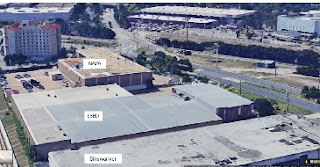

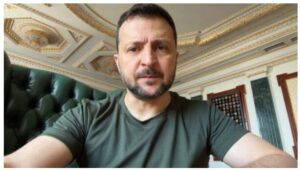
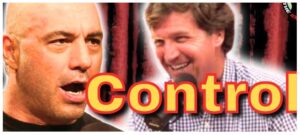
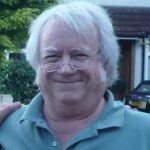

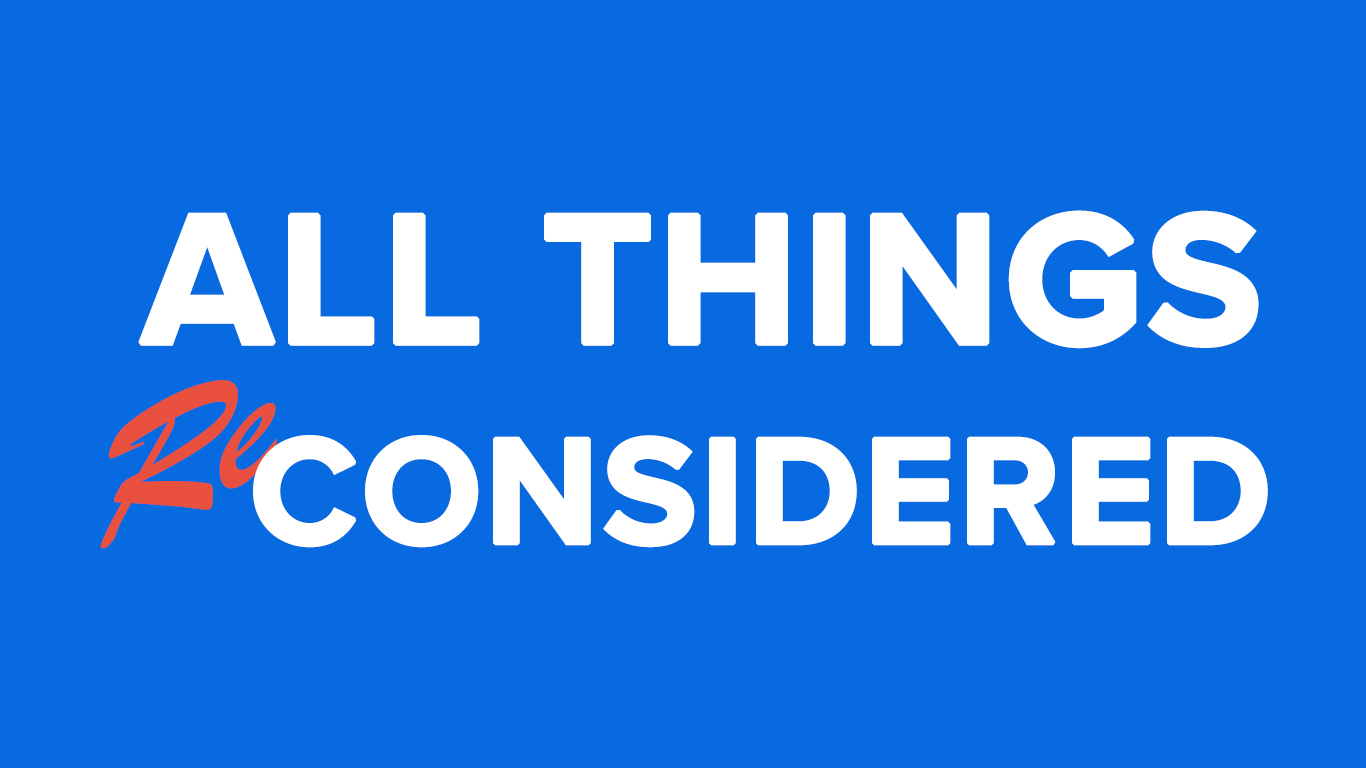
I've incorporated some of these JFK assassination arguments here
http://www.ciadidnotkilljfk.com
التخلص من الحشرات فى المطابخ
المطابخ من اكثر الاماكن التى نستخدمها يوميا ونظافة المطابخ تتدل على افراد اصحاء وعائله سليمة فنظافة المطابخ والتخلص من الحشرات من اهم الاشياء التى لابد من القيام بيها وعدم الانتظار الى ان تتكاثر وتنتشر فى المطابخ من اهم انواع الحشرات التى من الممكن ان تتعرض اليها الاتى :-
الصراصير الصغبرة فى المطابخ
شركة مكافحة حشرات بالخرج
مكافحة حشرات بالخرج
من اكثر انواع الحشرات التى يتم التعرض اليها فعليك اولا ان تتعرف على الاسباب التى تؤدى الى التعرض الى الصراصير والقضاء عليها نهائيا من اهم ما تقوم بيه الاهتمام بالتخلص من القمامه اول باول ، الاهتمام بالتخلص من بقايا الاطعمه ،التخلص من الردة ، التخلص من تسربات المياه تحت الاحواض لانها من البيئة الخصبة التى تساعد فى نمو الحشرات وتساعد فى تكاثرها وانتشارها ، الاهتمام بالبيارات ونظافتها وخاصه اذا كانت فى المطابخ هذه هى اهم الاسباب التى تؤدى الى انتشار الصراصير الصغيرة فى المطابخ فاذا كانت هناك اى مشكله واستعصى عليك الامر فتعاون معنا الان .
النمل الاسود فى المطابخ
شركة رش مبيدات بالخرج
شركة رش حشرات بالخرج
رش حشرات بالخرج
النمل الاسود من الحشرات التى تنتشر فى فصل الصيف وتزداد مع ارتفاع الحرارة فاذا كنت تعانى من النمل الاسود فعليك ان تهتم بالتخلص من فتافيت الاطعمه والتخلص من السكريات المتواجده على الطاوله ، الاهتمام بازاله القمامه وبالاضافة الى الاهتمام بالتعرف على الشقوق والاماكن الضيقه التى ينبعث منها النمل الاسود حتى لا يتم انتشار النمل الاسود فى المكان وطرق الوقاية التى تساعد فى القضاء عليها هو القيام بالتخلص من القمامه وفتافيت الطعام والتخلص من الاماكن التى ينبعث منها النمل بالاضافة الى وضع السمسم فى الاماكن التى ياتى منها النمل لانها تعمل على اعاقه الجهاز التنفسى للنمل والتخلص منه ، رش زيت البترول على ارجل الطاوله حتى لا تتعرض الى النمل
مكافحة النمل الابيض بالخرج
شركة مكافحة النمل الابيض بالخرج
عليها .
السوس فى التوابل
من الحشرات التى تاتى فى التوابل والارز السوس فعليك ان تهتم باعمال التنظيف بالاضافة الى عدم القيام بالاستعانه بانواع من التوابل القديمه او الارز القديم فهذه من اكثر
الطرق التى تساعد فى الحفاظ على التوابل من السوس .
خدماتنا متميزة عن غيرنا في مجال التسريبات سربات المياه والعوزال وحل بطرق سليمة دون التدمير فعندنا في شركة ركن البيت افضل يوجد افضل الفنين الممتزين في مجال التسربات والكشف عنها بدون اي مشاكل من خلال الطاقم التي تم تدريبه في شركة كشف تسربات المياه بالدمام فتعاملك معنا ستحصل علي خدمات متميزة
شركة كشف تسربات المياه بجدة
شركة كشف تسربات بجدة
شركة عزل خزانات بالرياض
شركة عزل اسطح بالرياض
شركة كشف تسربات بالدمام
شركة كشف تسربات بالرياض
شركة كشف تسربات المياه بالرياض
كشف تسربات المياه
Awesome things here. I am very glad to peer your article. Languages Translations|Translation Services
I can't find the memoirs of Laura Kittrell at the FBI site. How can I obtain them?
Nice blog and absolutely outstanding. You do something much better but i still say this perfect.Keep trying for the best.
pest control san antonio
#pestcontrolsanantonio
Is William a 'senior member' of Ralph's OIC ? Weren't you a 'senior member', James? So was Judyth.